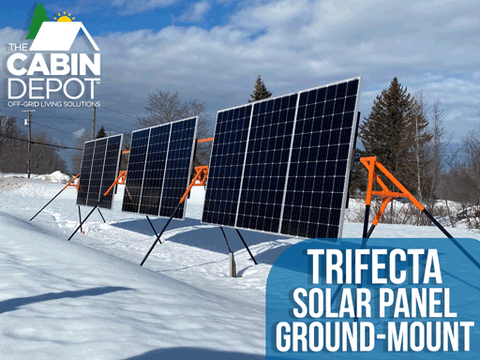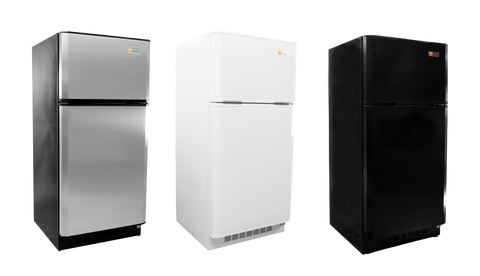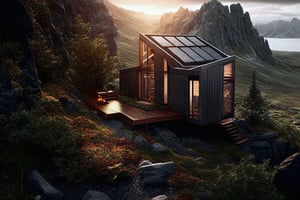Living off the grid with solar power is becoming increasingly popular, especially for those who...
5 Tips for Improving Off-Grid Solar Panel Winter Performance
The internet is full of conflicting information about solar energy. In particular, there's a lot of misunderstanding surrounding how solar panels can effectively be used to generate power in the winter.
Maybe you've had a solar salesperson come to your door and they've roped you into a 30 minute sales pitch about how solar power is going to save your life, your wallet, and your future great-grandchildren. Door-to-door solar salespeople will do everything under the sun to convince you that switching your grid-tied home to solar is the right choice. Unfortunately, a lot of the information they put out causes confusion for those of us who are looking to use solar for an off-grid cabin, cottage or camp, far from the power grid.
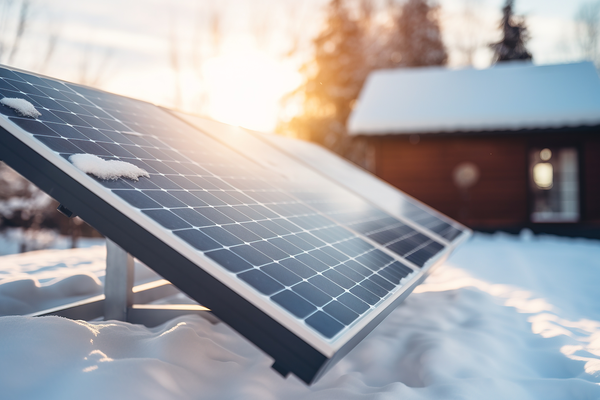
If you're researching online, you might read that your energy production in the winter really doesn't matter much, as it only accounts for a small fraction of losses annually. They say this, because with most net-metering power bills, it's true. You can use energy that was produced earlier in the year and fed into the grid, so it doesn't really amount to that much of a loss year-round. While this information is interesting, it does not apply to off-grid living, where every bit of power production is crucial.
Let's start by first addressing some of the most common misconceptions around using solar panels for off-grid living in the winter.
Do solar panels work in the winter?
Solar panels, when unobstructed by snow and pointing directly at the sun will perform well, but there's a few caveats. In the winter, the total duration of time that sunlight is received is much lower than the summer. Also, your panels receive less solar irradiance due to the 23.5° tilt of the Earth and our elliptical orbit around our star.
Solar irradiance is the amount of sunlight that reaches a solar panel. The more sunlight the panel receives, the more electricity it can generate.
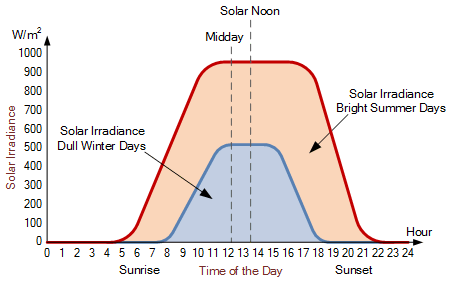
That said, solar panels do experience an unexpected effect that compensates slightly for the diminished sunlight - when solar panels are cold, their efficiency is improved. As solar panels get hotter, they produce less power from the same amount of sunlight.
Why do solar panels work better in the cold?
Long story short; Solar panels are less efficient when hot because their power output depends on the energy difference between electrons at rest and electrons excited by sunlight. Normally, sunlight excites electrons from a low-energy rest state, and the potential difference between the excited and rest state creates a voltage. However, heat from a summer sun can increase the rest energy of electrons. In hotter conditions, the energy difference between the rest and excited states is smaller, leading to less power production. Think of it like a waterslide: starting from the top of a building, you gain more speed than starting halfway down. The greater the height (potential difference), the faster the ride (more power generated).1
Will solar panels work if they're covered in snow?
Solar panels can technically still work when partially covered in snow. However, the power generated is almost 80-90% less than what you would get with a fully unobstructed panel in the sun. The energy production of the entire solar array can be affected by just one panel being covered in snow. So, solar-salesman have an answer to this, and this is something that you hear a lot about with grid-tied solar that really doesn't translate well to off-grid solar and causes confusion. Grid-tied solar installations typically use an additional component called an 'optimizer' on each panel. These optimizers optimize the current that travels across a string of solar panels so that no matter how the other panels are performing, you will still achieve the maximum power production possible. Unfortunately, for us off-grid folk, these optimizers are not designed or built for off-grid systems.
Off-grid systems rely on batteries for energy storage while grid-tied systems simply push power back into the grid. So the primary focus in off-grid systems is optimizing the charge current to ensure safe and efficient battery charging, instead of maximizing the output of each individual panel.
How can you get more power from your solar panels in the winter?
1. Clear the snow
You might be thinking, well, duh! But it's more important than you'd think. Have you ever heard the saying, 'a chain is only as strong as it's weakest link'? The same principle exists in strings of solar panels.
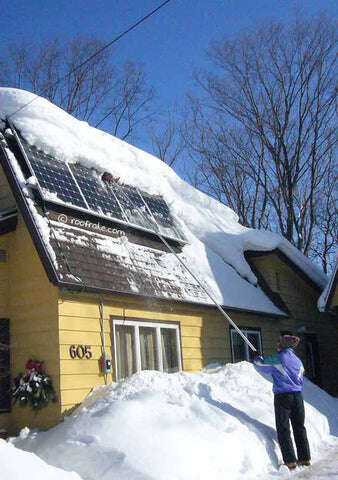
A string of panels can only perform as well as its worst performing panel. So if ice, snow, or a fallen leaf affect one panel’s performance, every other panel will operate at a diminished capacity. To see better results from your panels in the winter, you should remove the snow from your solar panels each snowfall.
2. Keep a high pitch
Keeping a higher pitched angle in the winter will do two things for you...
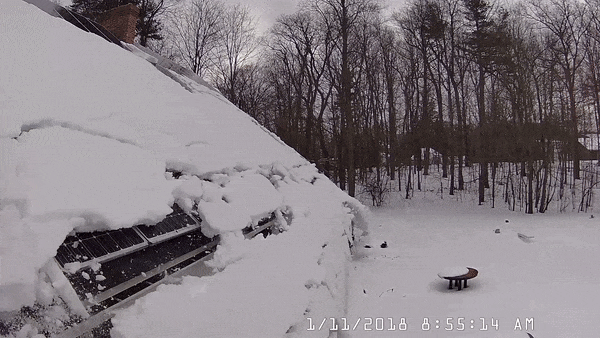
i) A higher angle allows the snow to slide off on its own. Solar panels (due to their black and reflective appearance) will absorb heat and melt snow as the sun shines.
ii) Tilting your panels up in the winter can provide improved efficiency. The sun changes position in the sky, slowly and gradually drifting closer and further in an ellipse pattern. Tilting your solar panels can compensate for this change in the position. In the winter, the sun sits lower in the sky, meaning a higher tilt angle will provide greater solar irradiance.
3. Find out exactly where the sun is going
There are smart phone apps out there that can use your camera, compass, and coordinates to provide an accurate visual representation of the trajectory of the sun in the sky. This is very useful when determining where to install your solar array, and also for determining what might be blocking the sun in the winter as it hangs lower in the sky.

One application we've used before was called 'SunTracker AR' (free to download, last time we checked), but there are lots of applications that do this same function.
4. Adjust your panel angle monthly
Okay, maybe adjusting your panels every month isn't practical for everyone, but more frequent adjustments can provide increased energy production. Seasonal adjustments are a more attainable goal. At the right angle, solar panels can capture more sunlight directly, which can increase their energy output. Depending on the location and season, this adjustment can lead to an approximate 10% to 25% increase in energy production compared to panels with a fixed angle.
At our store (which runs 100% on off-grid energy!) we use Trifecta Adjustable Solar Ground Mounts. These ground mounts require no heavy lifting: no digging, concrete, or heavy equipment. Their adjustable legs fit uneven terrains, and the mounts anchor to the ground very securely. (Our Trifecta mounts have survived two hurricanes with zero issue.) For Canadians, we developed an online solar angle calculator for determining the optimal seasonal/monthly angles for your panels.
In the winter, the Trifecta makes our life a whole lot easier. Whenever snow piles up, you can simply turn a wrench, tilt your array forward and let the snow fall off.
5. Cut down on energy intensive loads
Energy efficient appliances can be a lifesaver when it comes to the wintertime. If you haven't already, you should take the time to address every electrical load you use; then determine what could be minimized, improved or removed. Refrigerators, washing machines, and heating are commonly the largest electrical loads used in a home.
For heating, consider using propane direct vent heating or wood stoves rather than baseboards, heat pumps or electric heating. The best scenario is to have both a woodstove, and a supplementary propane direct vent heater. Using only electric heat effectively for off-grid living would require a pretty large solar system. If you're thinking of sizing your system specifically so you can use electric heating, it may as well be worth your time to explore the cost/benefits of using something like a Martin Heater instead.
For refrigeration, 12V/24V DC fridges can be wired directly to a battery bank, eliminating the need for an inverter and any energy loss from DC/AC conversion. Specific to fridges and freezers, SunStar Appliances are worth mentioning. All their appliances are built 100% in the USA (Indiana). Interestingly, their fridges were originally designed as an alternative to icehouses for Amish farming families. Their appliances boast an impressive 4" insulation, so the fridge compressor isn't working nearly as hard to keep the temperatures stable when compared to other thin-insulated solar appliances. Propane refrigerators/freezers by Unique are also an efficient option for areas where sunlight isn't as readily available.
The power used for washing and drying clothes can be improved by using propane-powered off-grid clothes washer/dryer combos. If your load sizes are small, consider using a hand-powered clothes washer.
Interested in learning more about Off-Grid Solar? Check out our 2024 Off-Grid Solar Guide.
References:
UCSB Scienceline - Does temperature affect the amount of energy a solar panel receives?
